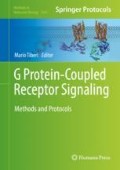Abstract
G protein-coupled receptors (GPCRs) are the target for many drugs. Evidence continues to accumulate demonstrating that multiple receptors form homo- and heteromeric complexes, which in turn dynamically couple with G proteins, and other interacting proteins. Here, we describe a method to simultaneously determine the identity of up to four distinct constituents of GPCR complexes using a combination of sequential bioluminescence resonance energy transfer 2—fluorescence resonance energy transfer (SRET2) with bimolecular fluorescence complementation (BiFC). The method is amenable to moderate throughput screening of changes in response to ligands and time-course analysis of protein–protein oligomerization.
Access this chapter
Tax calculation will be finalised at checkout
Purchases are for personal use only
References
Rios CD, Jordan BA, Gomes I et al (2001) G-protein-coupled receptor dimerization: Modulation of receptor function. Pharmacol Ther 92:71–87
Milligan G (2004) G protein-coupled receptor dimerization: function and ligand pharmacology. Mol Pharmacol 66:1–7
Milligan G (2009) G protein-coupled receptor hetero-dimerization: contribution to pharmacology and function. Br J Pharmacol 158:5–14
Ferré S, Casadó V, Devi LA et al (2014) G protein-coupled receptor oligomerization revisited: functional and pharmacological perspectives. Pharmacol Rev 66:413–434
Ferré S (2015) The GPCR heterotetramer: challenging classical pharmacology. Trends Pharmacol Sci 36:145–152
Franco R, Martínez-Pinilla E, Lanciego JL et al (2016) Basic pharmacological and structural evidence for class A G-protein-coupled receptor heteromerization. Front Pharmacol 7:76
Gaitonde SA, González-Maeso J (2017) Contribution of heteromerization to G protein-coupled receptor function. Curr Opin Pharmacol 32:23–31
Gomes I, Ayoub MA, Fujita W et al (2016) G protein-coupled receptor heteromers. Annu Rev Pharmacol Toxicol 56:403–425
James JR, Oliveira MI, Carmo AM et al (2006) A rigorous experimental framework for detecting protein oligomerization using bioluminescence resonance energy transfer. Nat Methods 3:1001–1006
Pfleger KD, Seeber RM, Eidne KA (2006) Bioluminescence resonance energy transfer (BRET) for the real-time detection of protein-protein interactions. Nat Protoc 1:337–345
Marullo S, Bouvier M (2007) Resonance energy transfer approaches in molecular pharmacology and beyond. Trends Pharmacol Sci 28:362–365
Carriba P, Navarro G, Ciruela F et al (2008) Detection of heteromerization of more than two proteins by sequential BRET-FRET. Nat Methods 5:727–733
Navarro G, McCormick PJ, Mallol J et al (2013) Detection of receptor heteromers involving dopamine receptors by the sequential BRET-FRET technology. Methods Mol Biol 964:95–105
Hu CD, Chinenov Y, Kerppola TK (2002) Visualization of interactions among bZIP and Rel family proteins in living cells using bimolecular fluorescence complementation. Mol Cell 9:789–798
Vidi PA, Przybyla JA, Hu CD et al (2010) Visualization of G protein-coupled receptor (GPCR) interactions in living cells using bimolecular fluorescence. Curr Protoc Neurosci. Chapter 5:Unit 5.29
Shyu YJ, Liu H, Deng X et al (2006) Identification of new fluorescent protein fragments for bimolecular fluorescence complementation analysis under physiological conditions. Biotech 40:61–66
Bagher AM, Laprairie RB, Toguri J et al (2017) Bidirectional allosteric interactions between cannabinoid receptor type 1 (CB1) and the dopamine receptor type 2 (D2) agonists mediated through CB1/D2L heterotetramers (2017). Eur J Pharmacol 813:66–83
Bagher AM, Laprairie RB, Kelly MEM et al (2018) Methods to quantify cell signaling and GPCR receptor ligand bias: characterization of drugs that target the endocannabinoid receptors in Huntington’s disease. Methods Mol Biol 1780:549–571
Author information
Authors and Affiliations
Corresponding author
Editor information
Editors and Affiliations
Rights and permissions
Copyright information
© 2019 Springer Science+Business Media, LLC, part of Springer Nature
About this protocol
Cite this protocol
Bagher, A.M., Kelly, M.E.M., Denovan-Wright, E.M. (2019). Combining SRET2 and BiFC to Study GPCR Heteromerization and Protein–Protein Interactions. In: Tiberi, M. (eds) G Protein-Coupled Receptor Signaling. Methods in Molecular Biology, vol 1947. Humana Press, New York, NY. https://doi.org/10.1007/978-1-4939-9121-1_11
Download citation
DOI: https://doi.org/10.1007/978-1-4939-9121-1_11
Published:
Publisher Name: Humana Press, New York, NY
Print ISBN: 978-1-4939-9120-4
Online ISBN: 978-1-4939-9121-1
eBook Packages: Springer Protocols

